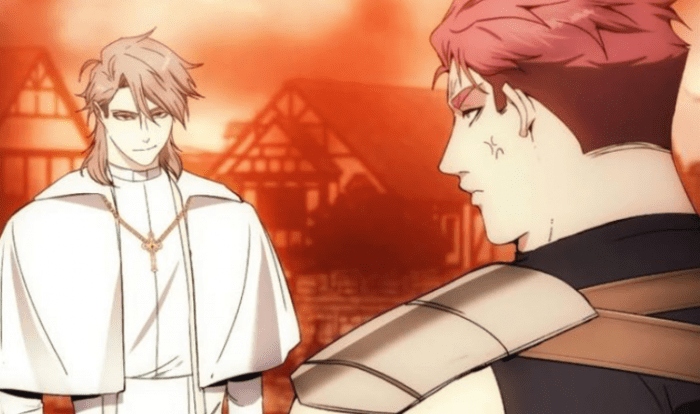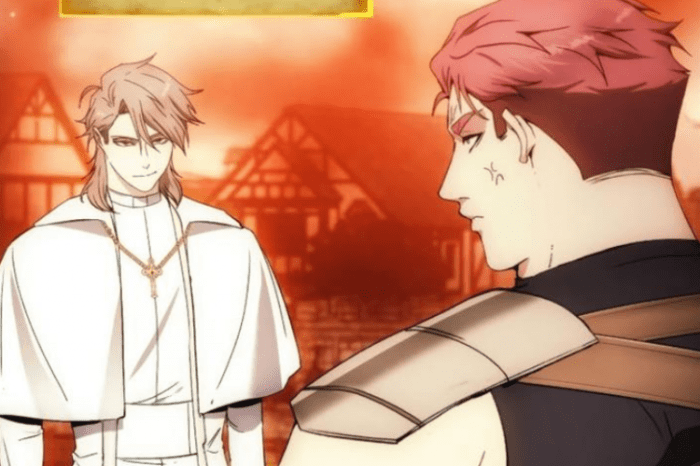
How to live as a villain ch 94 unveils the captivating world of villains, providing an in-depth exploration of their mindset, strategies, and the intricate relationships they form. This chapter delves into the psyche of these enigmatic characters, revealing the motivations and goals that drive their actions.
The narrative delves into the tactics and strategies employed by villains to build their empires, acquire power and influence, and navigate the treacherous landscape of deception, manipulation, and intimidation. It also sheds light on the complex dynamics of villainous alliances and the potential for betrayal and conflict within their organizations.
Villainous Mindset

In the realm of storytelling, villains serve as captivating characters who challenge heroes and drive the narrative forward. To portray a successful villain, it is essential to understand their unique mindset, motivations, and characteristics.
In the world of How to Live as a Villain, the sinister machinations of Chapter 94 unfold, leaving readers on the edge of their seats. While the tale of villainy continues to captivate, a timely reminder emerges: gum disease, a common ailment, can be effectively managed without the need for a dentist.
For those seeking guidance on this matter, a comprehensive resource can be found at how to cure gum disease without a dentist . As the saga of How to Live as a Villain continues, readers can rest assured that their dental health need not suffer.
A villain’s core trait is their unwavering belief in their own superiority and righteousness. They possess a strong sense of entitlement and a disdain for authority or social norms. Their actions are often driven by a thirst for power, revenge, or a desire to reshape the world according to their own twisted vision.
Motivations and Goals
The motivations of villains vary widely, from personal vendettas to grand schemes of world domination. Some seek revenge for past injustices, while others desire wealth, power, or recognition. Regardless of their specific goals, villains are united by their determination to achieve them at any cost.
Iconic Villains
Throughout history, literature, film, and other media have featured countless iconic villains who have captured the imaginations of audiences. From the cunning and manipulative Joker in “Batman” to the ruthless Darth Vader in “Star Wars,” these villains have become synonymous with evil and have left an enduring mark on popular culture.
Villainous Strategies
To establish a formidable villainous empire, cunning strategies and tactics are indispensable. These include acquiring power, influence, and resources, employing deception, manipulation, and intimidation, and fostering a loyal following.
Power can be amassed through strategic alliances, control over key resources, or possession of advanced technology. Influence is gained by manipulating public opinion, leveraging media channels, and exploiting societal weaknesses. Resources, such as wealth, manpower, and information, are essential for sustaining operations and executing villainous schemes.
In the latest chapter of the popular web novel “How to Live as a Villain,” the protagonist’s journey takes an unexpected turn. As he delves deeper into the shadowy underworld, he encounters the enigmatic figure of Franklin Mecconline, a renowned expert in the field of online education . Mecconline’s guidance proves invaluable as the protagonist navigates the treacherous path ahead, honing his skills and unraveling the secrets that lie in wait.
Deception, Manipulation, and Intimidation
Deception involves misleading others through fabrications, omissions, or distortions of truth. Manipulation employs psychological tactics to influence thoughts, emotions, and behaviors. Intimidation instills fear and discourages opposition, ensuring compliance and suppressing resistance.
- Employ agents to spread disinformation and sow discord among potential adversaries.
- Create false identities and infiltrate enemy organizations to gather intelligence and sabotage operations.
- Establish a network of informants to monitor the activities of rivals and gather sensitive information.
Villainous Allies and Enemies

In the world of villains, alliances and enmities are as fluid as the shifting sands of time. Villains may find themselves working together for mutual gain or locked in bitter conflicts over power, resources, or ideology.
Types of Villainous Allies
Villains may attract a diverse range of allies and followers, each with their unique motivations and capabilities. These may include:
- Henchmen and Minions:Loyal subordinates who carry out the villain’s orders without question.
- Associates:Other villains who share similar goals or enemies and are willing to cooperate on a temporary or permanent basis.
- Sympathizers:Individuals who may not actively participate in the villain’s schemes but support their cause or ideology.
Challenges and Benefits of Villainous Alliances
Forming alliances with other villains can provide certain advantages, such as increased resources, manpower, and strategic coordination. However, it also comes with its share of challenges:
- Trust Issues:Villains are inherently suspicious of one another, making it difficult to form lasting alliances.
- Power Struggles:Alliances can become unstable if one villain becomes too powerful or ambitious.
- Betrayal:Villains are known for their treachery, and alliances can easily be broken if one party sees an opportunity to gain an advantage.
Betrayal and Conflict within Villainous Organizations
Betrayal and conflict are common within villainous organizations. Villains may turn against each other for personal gain, ideological differences, or simply because they enjoy the thrill of chaos. This can lead to internal power struggles, infighting, and even the collapse of the organization itself.
Villainous Hideouts and Lairs

A villain’s lair is their sanctuary, a place where they can plan their schemes and escape the prying eyes of the law. It is often a reflection of their personality and their ambitions, and can be as simple or as elaborate as they desire.Some
villains prefer to hide in plain sight, using abandoned buildings or even their own homes as their lairs. Others build secret underground bunkers or mountain fortresses, complete with all the amenities they could ever need.No matter where it is located, a villain’s lair is always well-defended.
It may have hidden entrances, security cameras, and even traps to keep intruders out. The interior is often designed to be comfortable and functional, with everything the villain needs to carry out their plans.In addition to being a physical space, a villain’s lair can also be a symbol of their power and their ambition.
It is a place where they can feel safe and in control, and where they can indulge in their darkest desires.
Types of Villainous Hideouts
There are many different types of villainous hideouts, each with its own strengths and weaknesses. Some of the most common types include:
- Abandoned buildings:These are often easy to find and secure, but they can also be cramped and uncomfortable.
- Secret underground bunkers:These are more difficult to find and access, but they offer excellent protection from the elements and from intruders.
- Mountain fortresses:These are often located in remote areas, and they offer stunning views and a sense of isolation.
- Mobile lairs:These are often vehicles or aircraft that can be moved from place to place, making them difficult to track down.
The type of lair that a villain chooses will depend on their individual needs and preferences. Some villains may prefer a simple and functional lair, while others may desire something more elaborate and luxurious.
Symbolic Significance of a Villain’s Lair
A villain’s lair is more than just a place to live. It is also a reflection of their personality and their ambitions. The design of the lair can reveal a lot about the villain’s character, their motivations, and their fears.For
example, a villain who chooses to hide in an abandoned building may be trying to blend in with their surroundings and avoid detection. A villain who builds a secret underground bunker may be paranoid and fearful of attack. A villain who chooses a mountain fortress may be seeking power and control.The
symbolic significance of a villain’s lair can also be seen in the way that it is decorated. A villain who decorates their lair with dark colors and heavy furniture may be trying to create a sense of intimidation. A villain who decorates their lair with bright colors and whimsical objects may be trying to create a sense of chaos and confusion.No
matter how it is designed or decorated, a villain’s lair is always a reflection of their inner self. It is a place where they can feel safe and in control, and where they can indulge in their darkest desires.
Villainous Downfall
The downfall of a villain is a common trope in storytelling, and for good reason. It provides a satisfying conclusion to the hero’s journey and reinforces the moral that good will always triumph over evil. However, there are many different reasons why a villain might fall from power, and not all of them are due to the hero’s actions.
One of the most common reasons for a villain’s downfall is hubris. This is a Greek word that means “excessive pride or arrogance.” When a villain becomes too confident in their own abilities, they often make mistakes that lead to their downfall.
For example, the villain may underestimate the hero’s strength or they may overestimate their own abilities.
Another common reason for a villain’s downfall is overconfidence. This is when a villain becomes so sure of their victory that they neglect to take the necessary precautions. For example, the villain may fail to guard their lair or they may underestimate the threat posed by the hero.
Those eager to delve into the intricacies of ‘How to Live as a Villain’ Chapter 94 may also find valuable insights in the realm of dental hygiene. For those seeking to alleviate gum disease without professional intervention, this comprehensive guide offers practical solutions and expert advice.
As we return to the thrilling adventures of Chapter 94, remember to prioritize both your dental well-being and your villainous pursuits.
As a result, the villain is caught off guard and defeated.
Finally, a villain’s downfall can also be caused by external forces. These forces can include the actions of the hero, the intervention of a third party, or even just bad luck. For example, the villain may be betrayed by their henchmen, they may be defeated by a natural disaster, or they may simply be outmatched by the hero.
Not all villains who fall from power are doomed to stay down. Some villains are able to overcome their downfall and regain their power. These villains are often more resilient and determined than their counterparts. They are also willing to learn from their mistakes and adapt their plans accordingly.
One example of a villain who successfully overcame their downfall is Darth Vader. After being defeated by Luke Skywalker in Return of the Jedi, Vader was redeemed and returned to the light side of the Force. Another example is the Joker. After being defeated by Batman in The Dark Knight, the Joker escaped from Arkham Asylum and continued to terrorize Gotham City.
As the story progresses in “How to Live as a Villain” ch 94, the protagonist’s journey takes a significant turn. With newfound challenges and obstacles, they must navigate the treacherous path ahead, adapting their strategies and embracing their inner villain.
To delve deeper into this captivating chapter, visit how to live as a villain ch 94 for an immersive reading experience.
The downfall of a villain is a complex and often tragic event. However, it is also a reminder that even the most powerful villains can be defeated. With courage, determination, and a little bit of luck, the hero can always triumph over evil.
Hubris
Hubris is a Greek word that means “excessive pride or arrogance.” It is often seen as a character flaw that can lead to a person’s downfall. In the context of villains, hubris can lead to a number of mistakes that can ultimately lead to their defeat.
One of the most common ways that hubris can lead to a villain’s downfall is by causing them to underestimate their opponents. When a villain is too confident in their own abilities, they may fail to take the necessary precautions to protect themselves.
This can leave them vulnerable to attack from the hero or other forces.
Another way that hubris can lead to a villain’s downfall is by causing them to make reckless decisions. When a villain is convinced that they are invincible, they may take risks that they would not otherwise take. This can lead to them making mistakes that they cannot recover from.
Finally, hubris can also lead to a villain’s downfall by causing them to alienate their allies. When a villain is too arrogant, they may treat their allies with contempt. This can lead to the allies turning against the villain and joining forces with the hero.
Hubris is a dangerous character flaw that can lead to the downfall of even the most powerful villains. It is important for villains to be aware of the dangers of hubris and to take steps to avoid it.
Overconfidence, How to live as a villain ch 94
Overconfidence is another common character flaw that can lead to a villain’s downfall. Overconfidence is when a person is too confident in their own abilities. This can lead to them making mistakes that they would not otherwise make.
One of the most common ways that overconfidence can lead to a villain’s downfall is by causing them to underestimate their opponents. When a villain is too confident in their own abilities, they may fail to take the necessary precautions to protect themselves.
This can leave them vulnerable to attack from the hero or other forces.
Another way that overconfidence can lead to a villain’s downfall is by causing them to make reckless decisions. When a villain is convinced that they are invincible, they may take risks that they would not otherwise take. This can lead to them making mistakes that they cannot recover from.
Finally, overconfidence can also lead to a villain’s downfall by causing them to alienate their allies. When a villain is too confident, they may treat their allies with contempt. This can lead to the allies turning against the villain and joining forces with the hero.
Overconfidence is a dangerous character flaw that can lead to the downfall of even the most powerful villains. It is important for villains to be aware of the dangers of overconfidence and to take steps to avoid it.
External Forces
External forces can also play a role in a villain’s downfall. These forces can include the actions of the hero, the intervention of a third party, or even just bad luck.
One of the most common ways that external forces can lead to a villain’s downfall is by providing the hero with an opportunity to defeat them. For example, the hero may find a way to exploit the villain’s weakness or they may receive help from an unexpected source.
Another way that external forces can lead to a villain’s downfall is by disrupting their plans. For example, the hero may sabotage the villain’s lair or they may rally the support of the people against them. This can make it difficult for the villain to achieve their goals.
Chapter 94 of “How to Live as a Villain” explores the protagonist’s journey as they navigate the complexities of their new reality. Amidst the challenges they face, readers may find themselves drawn to the topic of gum disease. While it’s crucial to prioritize dental health, there are instances when access to a dentist may be limited.
For those seeking alternative solutions, how to cure gum disease without a dentist offers valuable insights. As the protagonist continues their journey in “How to Live as a Villain,” they may encounter situations where self-care measures become essential.
Finally, external forces can also lead to a villain’s downfall by simply overwhelming them. For example, the villain may be defeated by a natural disaster or they may be betrayed by their own allies. This can make it impossible for the villain to continue their reign of terror.
External forces can be a major factor in a villain’s downfall. It is important for villains to be aware of the potential threats that they face and to take steps to protect themselves from them.
Outcome Summary: How To Live As A Villain Ch 94
How to live as a villain ch 94 culminates in a thought-provoking analysis of the common pitfalls that lead to a villain’s downfall. It examines the role of hubris, overconfidence, and external forces in their ultimate demise, while also highlighting examples of villains who have defied these obstacles and regained their power.
Question & Answer Hub
What are the key traits of a successful villain?
Successful villains possess a combination of intelligence, charisma, and ruthlessness. They are driven by a strong sense of purpose and a willingness to do whatever it takes to achieve their goals.
How do villains build their empires?
Villains build their empires through a combination of strategic planning, manipulation, and intimidation. They often form alliances with other villains and use their resources to acquire power and influence.
What are the challenges of forming alliances with other villains?
Forming alliances with other villains can be challenging due to the potential for betrayal and conflict. Villains are often driven by their own self-interests and may be willing to sacrifice their allies to achieve their goals.





